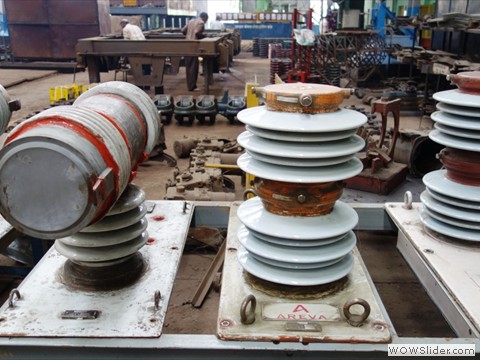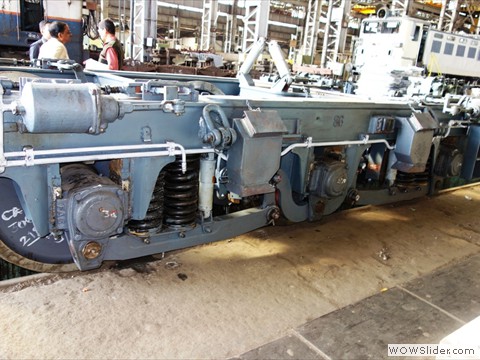How a locomotive works a train?
When we were child, looking at the mammoth size of steam engine powering the train was a wonderful sight. The wheel in front of the loco pilot was assumed to be driving wheel similar to road vehicle. Self steering rail-wheel profile is the reason for negotiating on curve and the wheel in front of the loco pilot is controlling the input of steam was understood much later. Rail Technologies has remained confined to very few attached to Railways profession either directly or indirectly. Whereas road technologies have opened up large opportunities of door to door transportation with accessibility to remote corners of the land and very high level of job creation at manufacturing, sale, maintenance, distribution network of fuel etc. It is the automobile transport which has led the manufacturing innovations, setting new standards in production technology, development of material for maintenance free concepts etc. Rail transport took a back seat with air and road transport advancing very fast. In road as well as air, the fossil fuel is directly converted into mechanical energy to drive the vehicle except for Battery driven road vehicle. Why there is a so much of research to develop use of electric power through plug or solar energy charging battery to drive road vehicle? While searching an answer to this basic question, planners and policy makers realizing the environment and energy benefits of Rail transport, it has now started moving toward driving seat. There are three types of locomotive developed namely Steam, Diesel and Electric.
Steam Locomotive
Steam Locomotive has always been a subject of curiosity among generation from the time introduced over Indian Railways. This was also for the reason that this was the only mode of mechanical transport as road transport was not invented at that time. Railways have mainly been identified by its rhythm sound most popularly called chuk-chuk gaadi. Source of motive power in a steam locomotive is coal, fuel energy of which is used to generate steam at high pressure. The high pressure steam works a piston driving the wheel through crank connection. With advancement of technologies led to introduction of electric and diesel locomotive replacing steam locomotive which has now gone into oblivion. Steam locomotive now only runs historical or tourist trains to show case the history of Railways. With the advent of electricity and electrical motor, and many advantages associated with electric and diesel traction, it replaced the steam traction. For Electric traction, basic fuel is still coal only, but efficient use in large power houses, electricity driving traction motor with better maneuverability of speed and traction control favored the change.
How an electric Locomotive functions
The functioning of electric locomotive involves current collection by a pantograph continuously touching the over head wire, running over the bus-bar of the locomotive roof to surge arrester and Vacuum circuit breaker (earlier Air Blast Circuit Breaker popularly called DJ). Output of vacuüm circuit breaker is connected to transformer through cable head termination (formerly condenser bushing). Output of Transformer is processed to feed traction motor. Development of processing technology over the last 80 years has led to different class of locomotive of which three class of locomotive is in operation over Indian Railways. There are three types of locomotive operating over Indian Railways with different power conversion configuration.
- Single phase transformer with Tap changer of 32 notches at primary side and two secondary winding to feed two circuits of three traction motor connected in parallel, using bridge rectified to convert AC into DC. and smoothing reactor. This configuration is in WAM4, WAG5, WAG7, WAP1, WAP4 class of locomotive.
 Pantograph and other Roof Equipment
Pantograph and other Roof Equipment Vacuum Circuit Breaker
Vacuum Circuit Breaker Roof Mounted Dynamic Brake Resistor
Roof Mounted Dynamic Brake Resistor Transformer Assembly of WAG7 Class locomotive
Transformer Assembly of WAG7 Class locomotive Top View of Complete Assembled Bogie with Traction Motor
Top View of Complete Assembled Bogie with Traction Motor Side View of Assembled Bogie
Side View of Assembled Bogie
 DC Series Traction Motor of Hitachi Design for WAG7 Locomotive
DC Series Traction Motor of Hitachi Design for WAG7 Locomotive
- Single Phase transformer with two secondary feeding to Thyristor base controlled rectifier converting AC` into controllable DC (WAG6A,B&C). The circuit configuration is same as above except diode bridge rectified is replaced by thyristor base controlled bridge rectifier. The transformer is step down transformer without having winding for different steps and controlled output is obtained by controlling through firing angle of thyristor. Indian Railways did not pursue this technology because of development of GTO with three phase traction motor. Presently Indian Railways is having only 18 locomotives and working in a dedicated Vishakapatnam-Kirandul route of VSKP division of ECOR.
- Single phase transformer with step down output fed to line and load side converter using three phase traction motor. Converter-Inverter set converts AC into DC link and then three phases AC.
Step by step action taken by Loco pilot to energize the locomotive and work a train
Step by step action for car driver is take ignition, press the clutch, take first gear and start the car with step by step change of gear depending on the speed.
For locomotive during start
- Start baby compressor working on Battery Voltage and build up pressure to 6 Kg.
- Raise the pantograph and close the Vac. circuit breaker as soon the pantograph touches the over head wire.
- With this three phase power supply will not will be available to work the auxiliary machines. Start the main compressor to built pressure in the locomotive and brake and feed pipe of the train.
- Check the continuity of pressure with the guard of the train.
- Exchange the signal with the guard about the readiness of the train.
- Take traction notch slowly keeping a watch on the traction motor current which should be in green/yellow zone. The train starts rolling. If it does not, means brake not released.
During working a train
- Keep a constant and vigilant watch on the section ahead
- Keep whistling to warn while passing a Railway Station, Level X-ing gate and on seeing any live obstruction on the route
- Keep watching pressure, speed, notch position, traction motor current etc.
- Watch the train in the rear while negotiating curve for any abnormality
- Exchange hand signal with the guard at start of train from any stoppage, with station staff and train crew passing on the adjacent line
- Repeat signal aspect after it is shouted by Assistant Loco Pilot
- Assistant Loco Pilot to record the time of passing a station and any other observation during run
- Assistant Loco Pilot to take a round inside the locomotive for any unusual particularly after passing a neutral section
- Making best use of braking system with first priority of regenerative, rheostatic and then mechanical.
Modern Locomotives are equipped with automatic control features making the train working simple helping the loco pilot in many ways. The system of working is set based on the primitive design of locomotive. The old working system has continued to be copied on the model design as well in the name of safety. Job of Loco pilot can be simplified a lot taking advantage of features of modern technology.
Why India shall not consider only one member crew in the locomotive?
In the name of safety and tough job, it is a taboo even to think of it among Indian Railway Management decision makers.
You may also like:
- Selection of Suspension Arrangement of Traction Motors : A Right…
- What is Electricity, Drift Velocity and Electric Current?
- Weight Transfer during Braking
- Re-engineering of Stators of Three phase Traction Motors type 6FRA…
- Multiple Choice Question on Basic Concept of Science Class X…
- Selection of Suspension Arrangement of Traction Motors : A Right…

 1
1 2
2 3
3 4
4 5
5 6
6 7
7
HOW WORKING RAIL ENGINE